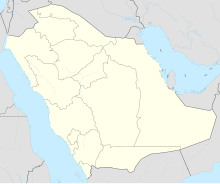Mahazat-as-Sayd Sanctuary
Coordinates: 22 ° 12 ′ 12 ″ N , 41 ° 49 ′ 36 ″ E
The Mahazat-as-Sayd Sanctuary ( Arabic محمية محازة الصيد, DMG Maḥmiyyat Maḥāzat aṣ-Ṣaid ) is located in Saudi Arabia , approx. 180 km northeast of Ta'if on the road from Mecca to Riyadh . The entire area is fenced and covers an area of 2,244 square kilometers.
history
Mahazat as-Sayd was designated as a protected area in 1988 and a year later it was fenced in over an area of 2,244 square kilometers to prevent livestock of the population from entering and grazing the area too heavily.
Geography and vegetation
It is a slightly undulating plain with an arid climate. The mean annual amount of precipitation is about 100 mm. Thanks to the fence, which protects the area from overgrazing by domestic animals, the reserve's vegetation was able to regenerate itself in an astonishing way and now looks more like a savannah than the surrounding, barren desert areas.
Wildlife
Arabian oryx , Arabian goitered gazelles , African ostriches (to replace the extinct Arabian ostrich ), and collared bustards were released into the reserve . There are also red foxes , sand foxes , sand cats , black cats and honey badgers . The reserve is an important breeding area for the threatened lappet vulture and a stopover for numerous migratory birds. Originally the area was also home to wolves, cheetahs, striped hyenas, Saudi gazelles, and Edmiga gazelles .
The populations of the oryx have increased significantly in the meantime. The number of animals in the reserve was over 700 in 2003. The maximum carrying capacity of the area was estimated at 850 animals. However, extreme drought in the region caused Arabian oryx populations to drop from around 600 in 2006 to below 400 in 2008. The number of Arab goitered gazelles fell from 1200 to around 700 in the same period. The fences of the reserve are partly responsible for the high losses, as they prevent the animals from leaving the area. Compared to comparable studies that deal with the decline in the population of large wild animals in times of drought, however, the losses are still classified as moderate.
Web links
- World Database on Protected Areas - Mahazat as-Sayd Protected Area (English)
- Mahazat as-Sayd on the page arabian-oryx.gov.sa (English)
Individual evidence
- ↑ a b Arabian oryx re-introduction in Mahazat as-Sayd protected area - Saudi Arabia: from rehabilitation to population management. Re-introduction News, No. 23, 2003 ( PDF, English ( page no longer available , search in web archives ) Info: The link was automatically marked as defective. Please check the link according to the instructions and then remove this notice. )
- ↑ a b Islam, M., Z., Ismail, K., Boug, A. (2010). Catastrophic die-off of globally threatened Arabian Oryx and Sand Gazelle in the fenced protected area of the arid central Saudi Arabia. Journal of Threatened Taxa 2 (2): 677-684
